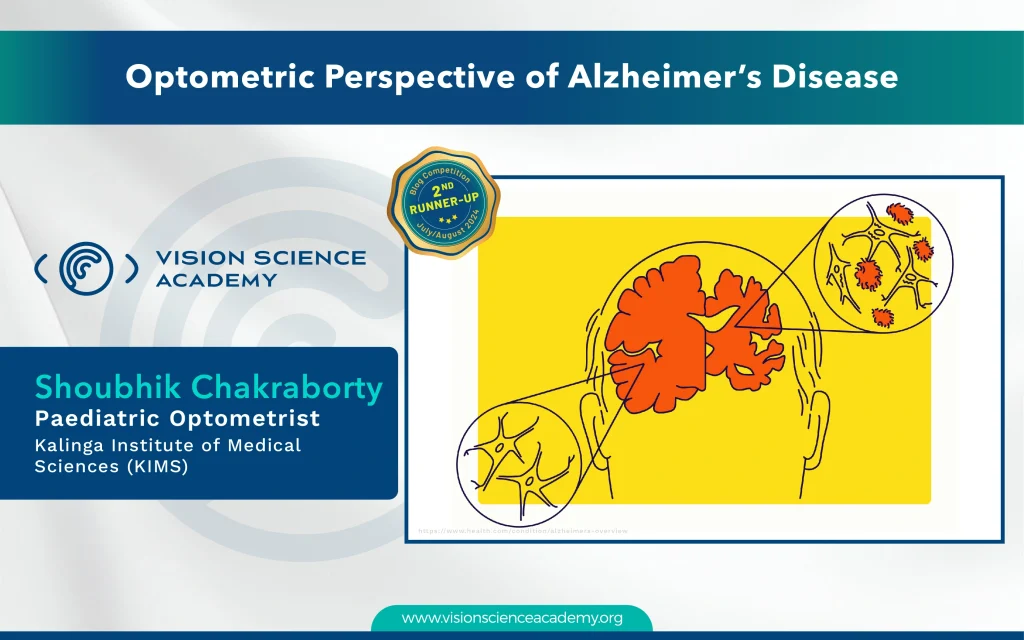Shoubhik Chakraborty, B. Optom
Paediatric Optometrist, Kalinga Institute of Medical Sciences (KIMS), Bhubaneswar, India
Introduction:
Alzheimer’s disease causes brain shrinkage and brain cell death. It is the main cause of dementia, with impaired memory, thinking, behaviour, and social skills. (1) Age, environmental, and genetic factors play a role in the aetiology of Alzheimer’s disease. About 24 million people worldwide have Alzheimer’s disease, including 8.8 million Indians above the age of 60 years. People with Alzheimer’s disease often have forgetfulness, struggle to think, confusion, acting out, cognitive difficulties, poor maths skills, and difficulty communicating with others. (2)
Optometrist’s Concern:
- Visual agnosia: A common phenomenon seen in Alzheimer’s despite having proper visual acuity, contrast sensitivity, visual field, and colour perception due to demyelination of the cortical fibres visual recognition is impaired. (3)
- Alexia: Recognition is a multi-layered process, understanding words and reading involves all the lobes like the frontal lobe for initiating saccade for the pursuit of parietal-occipital-temporal junction, and for letter recognition, the left temporal lobe for sign and symbol recognition, the right temporal lobe. Any demyelination in the brain region can hamper our visual function.
- Visual-spatial disorientation: Visual-spatial is the function of the dorsal stream due to involvement of the parieto-occipital lobe caused by age-related changes; patients may feel disorientated in the visual space.
Poor visual memory is the early diagnostic tool for Alzheimer’s, the main area for the impairment will reflect through perceiving, judging, reasoning, learning, evaluating, and remembering.
Figure 1 : Example of visual perception task
[Image reference https://www.dreamstime.com/form-constancy-worksheet-visual-perceptual-skills-activity-occupation-therapy-arrow-recognition-preschool-kindergarten-image235876024]
Optometric Management:
- Visual perceptual therapy can retrain cortical fibres for better perception by involving all the lobes of the brain for example in Figure 1, the patient must colour down the arrow by first cancellation of other directing arrow, then identifying the correct arrow. (4)
- HTS software-based computerised perceptual therapy (CPT) is very useful for brain damage. The most important benefit can also be prescribed for home-based. Figure 2 demonstrates the main tasks related to the CPT program.
- Brain tissues are like muscles if you don’t use them, they will degenerate easily, through letter finding in the newspaper with an appropriate near addition lens can enhance brain power through regular practice. (5)
Figure 2: Task Available on Computerised Perceptual Task Software
[Image reference https://htsvision.com/cpt-computerised-perceptual-processing/]
Early detection by a Visuo-cognitive test can introduce proper management on time.
Declaration of interest: No financial interest
Reference:
- Armstrong, R. A. (2009). Alzheimer’s disease and the eye. Journal of Optometry, 2(3), 103-111.
- Valenti, D. A. (2010). Alzheimer’s disease: visual system review. Optometry-Journal of the American Optometric Association, 81(1), 12-21.
- Neiberg, M. N. (2009). OPTOMETRIC PERSPECTIVE OF ALZHEIMER’S DISEASE. Journal of Behavioral Optometry, 20(1).
- Chakraborty, S., & Optom, B. Article• Outcomes Of Vision Therapy Among Children with Cerebral Visual Impairment: A Retrospective Study.
- Ungerleider LG, Haxby JV. ‘What’and ‘where’in the human brain. Current opinion in neurobiology. 1994 Jan 1;4(2):157-65.
